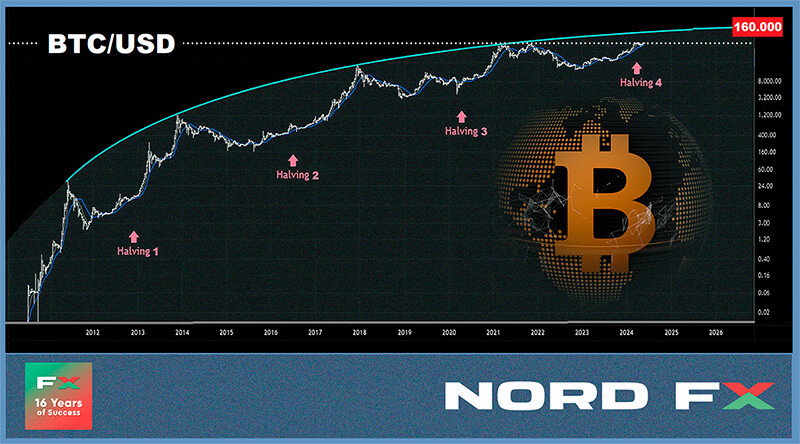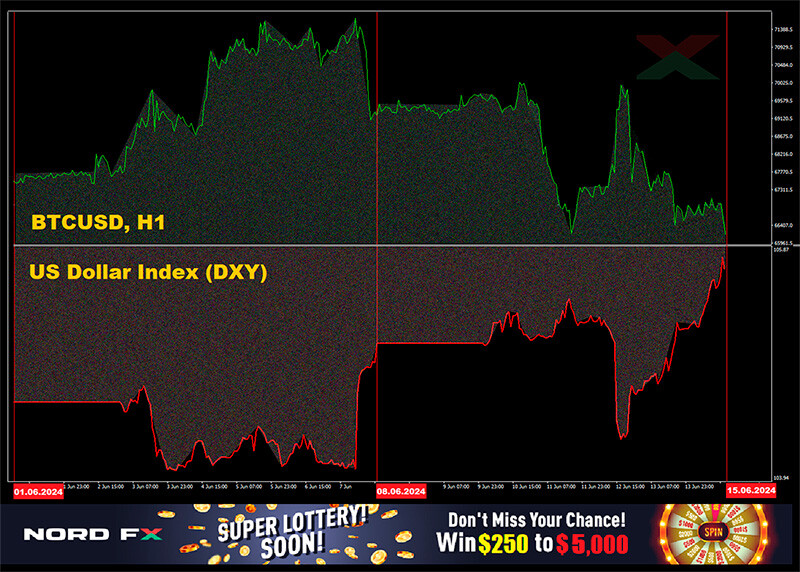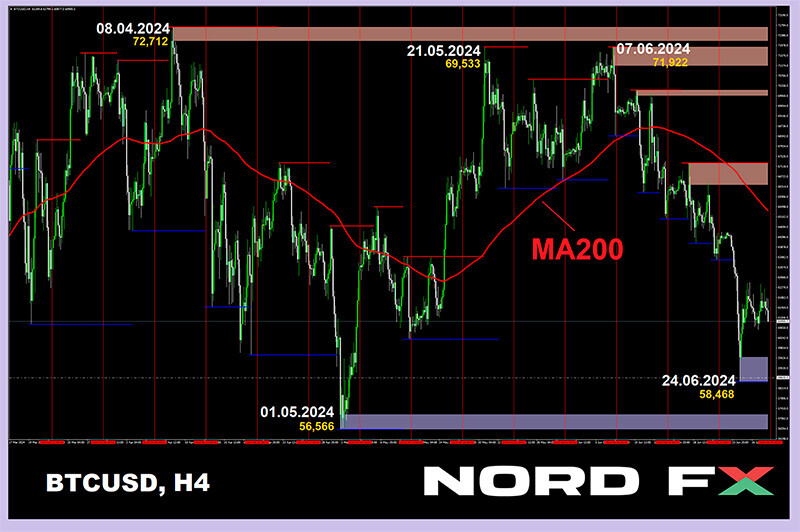CryptoNews of the Week

– The first cryptocurrency has once again risen above the $70,000 mark. The Hash Ribbons indicator is giving an “optimal signal” for buying digital gold in the coming weeks, suggesting a resumption of the asset’s rally, according to Capriole Investments founder Charles Edwards. The metric indicates miner capitulation that began two weeks ago, a period when the 30-day moving average hash rate falls below the 60-day average.
Edwards notes that miner capitulation occurs approximately once a year, usually linked to shutdowns, bankruptcies, acquisitions, or halving events. The recent miner capitulation was observed in 2023 when bitcoin traded around $20,000. If a new growth impulse occurs, the next medium-term target will be $100,000. However, entering the traditionally quiet summer financial market could delay this upward momentum, Edwards warns.
– The analyst known as Rekt Capital believes that to enter a “parabolic growth phase,” digital gold will need to confidently overcome the resistance zone of $72,000-$73,000. Popular cryptocurrency expert Ali Martinez predicts that BTC will likely test the price range of $79,600. The Artificial Intelligence tool PricePredictions has determined that in the coming days, bitcoin could not only firmly consolidate above the crucial $70,000 mark but also continue to rise, reaching $75,245 by the end of June. This forecast is based on technical analysis indicators such as the Relative Strength Index (RSI), Bollinger Bands (BB), and Moving Average Convergence Divergence (MACD).
– On 2 June, Dogecoin token graphic designer known as DogeDesigner discovered a live stream on YouTube featuring a deepfake of Tesla and SpaceX CEO Elon Musk promoting a cryptocurrency scam. The fake Musk offers users to scan a QR code on the screen leading to a giveaway site. "On the site, you can deposit any amount of bitcoin, Ethereum, and Dogecoin without any registration. Once you do, you'll receive double the amount of the deposited cryptocurrency," promises the fake entrepreneur. The scammers' channel closely resembles the official Tesla page and even has nearly 15,000 subscribers, while the original has 2.65 million.
– Venture investor Chamath Palihapitiya discussed one pathway for the mass adoption of bitcoin on the All-In podcast, predicting its price could rise to $500,000. The billionaire explained that the “powerful concept” of digital gold adoption was elucidated to him by Xapo CEO Wences Casares, an Argentine entrepreneur in venture investment.
Casares believes more countries will notice bitcoin while retaining their national currencies, effectively becoming dual-currency nations. One asset will be used for transactions with everyday goods and services, while the other – cryptocurrency – will act as a store of value. The United States could be among the first to follow this path, according to the entrepreneur.
Palihapitiya also noted that Casares suggested analysing bitcoin dynamics after halvings. The investor observed that the cryptocurrency's highest growth occurred 12-18 months post-event. Palihapitiya predicts that if the growth trajectory following the third halving repeats, bitcoin's price could reach $500,000 by October 2025. Taking the average of the last two cycles, the price target could be $1.14 million.
– According to a recent Harris Poll, geopolitical tension and inflation are prompting an increasing number of American voters to turn to bitcoin. The poll, sponsored by BTC-ETF issuer Grayscale, revealed that one in three U.S. voters will consider a Presidential candidate’s stance on cryptocurrencies before casting their vote. The survey polled over 1,700 potential U.S. voters, 77% of whom believe Presidential candidates should have at least some understanding of cryptocurrencies. Additionally, 47% of respondents plan to include cryptocurrency in their investment portfolios, up from 40% last year. Notably, following the approval of BTC-ETF, 9% of elderly voters also reported increased interest in investing in bitcoin or other crypto assets.
– The founder of the world's largest cryptocurrency exchange, Binance, Changpeng Zhao, has entered a federal high-security prison in California, where he will spend the next four months. The crypto community quickly expressed support for the former Binance CEO. A Reddit user, Ilsemprelaziale, commented that Zhao's imprisonment is a step to protect the crypto exchange and the entire industry from potential risks. "If the FTX collapse hit cryptocurrency hard, just imagine what would happen if Binance fell. But he pleaded guilty and stepped down as CEO," Ilsemprelaziale wrote.
After the sentencing, Changpeng Zhao shared plans for his post-prison life, stating he will continue to be actively involved in the crypto community. For instance, the former Binance head plans to engage in passive investing using his existing crypto assets.
– Mexican billionaire Ricardo Salinas urged his followers to buy bitcoin to protect against the devaluation of national currencies and preserve their savings. The owner of Salinas Group, whose wealth is estimated at over $14 billion, cited the fall of the Nigerian naira as an example.
Currently, Nigeria's official currency is experiencing a difficult period, prompting the local government to take several stabilization measures. The country's authorities have also tightened their stance on cryptocurrency companies – in March, the Nigerian Securities and Exchange Commission proposed increasing the registration fee by 400%. The head of Binance’s Financial Crimes Compliance unit, Tigran Gambaryan, is still imprisoned in Nigeria on charges of tax evasion.
– The crypto wallets of well-known personalities have long attracted the attention of curious community members. One of the largest holders of cryptocurrency, as it turns out, is the founder of Tron, Justin Sun, who, according to Arkham Intelligence, owns crypto assets worth $1.03 billion. His largest reserves are in USDD stablecoins, valued at $276 million. Additionally, Arkham calculated that he holds $240 million in TRX and about $100 million in BTC.
The wealth of Ethereum co-founder Vitalik Buterin is estimated to be a comparable amount at $935 million, with most of his holdings in ETH, valued at over $930 million. Pop stars' holdings are significantly smaller. For example, singer Justin Bieber owns ETH tokens worth about $575,000. Socialite Paris Hilton has digital assets worth only $53,000.
– Tether (USDT stablecoins) co-founder, former actor, and 2020 U.S. presidential candidate Brock Pierce is confident that Chinese authorities will lift the cryptocurrency ban. “Will China become open to cryptocurrencies? I can say it's inevitable. The main question is not whether it will happen, but when it will happen,” he stated.
In 2021, the Chinese government included the trading and mining of digital assets in the list of illegal activities. However, a grey crypto market has developed in the country. Pierce believes Hong Kong could become China’s cryptocurrency trading hub. However, this is not currently the case, as the Securities and Futures Commission (SFC) of this administrative region of China has prohibited local companies from providing digital asset services to mainland China residents. As a result, many firms have withdrawn their applications for virtual currency trading licenses submitted to the SFC.
– CEO of investment company Galaxy Digital, Mike Novogratz, predicted which crypto asset could become a serious contender for launching new cryptocurrency exchange-traded funds (ETFs) in the U.S. Over the past year, the most impressive results were shown by the cryptocurrency Solana. At the end of 2023, SOL was trading around $21, but by March 2024, it had exceeded $200, showing nearly tenfold growth. Currently, SOL is valued at around $172 and ranks among the top five cryptocurrencies by market capitalization. Given Solana's current status, Novogratz is confident that this altcoin has every chance to be included in the pool of spot ETFs. Recently, Brian Kelly, CEO of investment company BKCM, expressed a similar view.
Responding to Novogratz, the crypto enthusiast known as Digital Asset Investor suggested that SOL's price increase was due to the collapse of the FTX crypto exchange in autumn 2022 and “too many connections with the authorities.”
Notice: These materials should not be deemed a recommendation for investment or guidance for working on financial markets: they are for informative purposes only. Trading on financial markets is risky and can lead to a loss of money deposited.
#eurusd #gbpusd #usdjpy #btcusd #ethusd #ltcusd #xrpusd #forex #forex_example #signals #cryptocurrencies #bitcoin #stock_market
https://nordfx.com/

– The first cryptocurrency has once again risen above the $70,000 mark. The Hash Ribbons indicator is giving an “optimal signal” for buying digital gold in the coming weeks, suggesting a resumption of the asset’s rally, according to Capriole Investments founder Charles Edwards. The metric indicates miner capitulation that began two weeks ago, a period when the 30-day moving average hash rate falls below the 60-day average.
Edwards notes that miner capitulation occurs approximately once a year, usually linked to shutdowns, bankruptcies, acquisitions, or halving events. The recent miner capitulation was observed in 2023 when bitcoin traded around $20,000. If a new growth impulse occurs, the next medium-term target will be $100,000. However, entering the traditionally quiet summer financial market could delay this upward momentum, Edwards warns.
– The analyst known as Rekt Capital believes that to enter a “parabolic growth phase,” digital gold will need to confidently overcome the resistance zone of $72,000-$73,000. Popular cryptocurrency expert Ali Martinez predicts that BTC will likely test the price range of $79,600. The Artificial Intelligence tool PricePredictions has determined that in the coming days, bitcoin could not only firmly consolidate above the crucial $70,000 mark but also continue to rise, reaching $75,245 by the end of June. This forecast is based on technical analysis indicators such as the Relative Strength Index (RSI), Bollinger Bands (BB), and Moving Average Convergence Divergence (MACD).
– On 2 June, Dogecoin token graphic designer known as DogeDesigner discovered a live stream on YouTube featuring a deepfake of Tesla and SpaceX CEO Elon Musk promoting a cryptocurrency scam. The fake Musk offers users to scan a QR code on the screen leading to a giveaway site. "On the site, you can deposit any amount of bitcoin, Ethereum, and Dogecoin without any registration. Once you do, you'll receive double the amount of the deposited cryptocurrency," promises the fake entrepreneur. The scammers' channel closely resembles the official Tesla page and even has nearly 15,000 subscribers, while the original has 2.65 million.
– Venture investor Chamath Palihapitiya discussed one pathway for the mass adoption of bitcoin on the All-In podcast, predicting its price could rise to $500,000. The billionaire explained that the “powerful concept” of digital gold adoption was elucidated to him by Xapo CEO Wences Casares, an Argentine entrepreneur in venture investment.
Casares believes more countries will notice bitcoin while retaining their national currencies, effectively becoming dual-currency nations. One asset will be used for transactions with everyday goods and services, while the other – cryptocurrency – will act as a store of value. The United States could be among the first to follow this path, according to the entrepreneur.
Palihapitiya also noted that Casares suggested analysing bitcoin dynamics after halvings. The investor observed that the cryptocurrency's highest growth occurred 12-18 months post-event. Palihapitiya predicts that if the growth trajectory following the third halving repeats, bitcoin's price could reach $500,000 by October 2025. Taking the average of the last two cycles, the price target could be $1.14 million.
– According to a recent Harris Poll, geopolitical tension and inflation are prompting an increasing number of American voters to turn to bitcoin. The poll, sponsored by BTC-ETF issuer Grayscale, revealed that one in three U.S. voters will consider a Presidential candidate’s stance on cryptocurrencies before casting their vote. The survey polled over 1,700 potential U.S. voters, 77% of whom believe Presidential candidates should have at least some understanding of cryptocurrencies. Additionally, 47% of respondents plan to include cryptocurrency in their investment portfolios, up from 40% last year. Notably, following the approval of BTC-ETF, 9% of elderly voters also reported increased interest in investing in bitcoin or other crypto assets.
– The founder of the world's largest cryptocurrency exchange, Binance, Changpeng Zhao, has entered a federal high-security prison in California, where he will spend the next four months. The crypto community quickly expressed support for the former Binance CEO. A Reddit user, Ilsemprelaziale, commented that Zhao's imprisonment is a step to protect the crypto exchange and the entire industry from potential risks. "If the FTX collapse hit cryptocurrency hard, just imagine what would happen if Binance fell. But he pleaded guilty and stepped down as CEO," Ilsemprelaziale wrote.
After the sentencing, Changpeng Zhao shared plans for his post-prison life, stating he will continue to be actively involved in the crypto community. For instance, the former Binance head plans to engage in passive investing using his existing crypto assets.
– Mexican billionaire Ricardo Salinas urged his followers to buy bitcoin to protect against the devaluation of national currencies and preserve their savings. The owner of Salinas Group, whose wealth is estimated at over $14 billion, cited the fall of the Nigerian naira as an example.
Currently, Nigeria's official currency is experiencing a difficult period, prompting the local government to take several stabilization measures. The country's authorities have also tightened their stance on cryptocurrency companies – in March, the Nigerian Securities and Exchange Commission proposed increasing the registration fee by 400%. The head of Binance’s Financial Crimes Compliance unit, Tigran Gambaryan, is still imprisoned in Nigeria on charges of tax evasion.
– The crypto wallets of well-known personalities have long attracted the attention of curious community members. One of the largest holders of cryptocurrency, as it turns out, is the founder of Tron, Justin Sun, who, according to Arkham Intelligence, owns crypto assets worth $1.03 billion. His largest reserves are in USDD stablecoins, valued at $276 million. Additionally, Arkham calculated that he holds $240 million in TRX and about $100 million in BTC.
The wealth of Ethereum co-founder Vitalik Buterin is estimated to be a comparable amount at $935 million, with most of his holdings in ETH, valued at over $930 million. Pop stars' holdings are significantly smaller. For example, singer Justin Bieber owns ETH tokens worth about $575,000. Socialite Paris Hilton has digital assets worth only $53,000.
– Tether (USDT stablecoins) co-founder, former actor, and 2020 U.S. presidential candidate Brock Pierce is confident that Chinese authorities will lift the cryptocurrency ban. “Will China become open to cryptocurrencies? I can say it's inevitable. The main question is not whether it will happen, but when it will happen,” he stated.
In 2021, the Chinese government included the trading and mining of digital assets in the list of illegal activities. However, a grey crypto market has developed in the country. Pierce believes Hong Kong could become China’s cryptocurrency trading hub. However, this is not currently the case, as the Securities and Futures Commission (SFC) of this administrative region of China has prohibited local companies from providing digital asset services to mainland China residents. As a result, many firms have withdrawn their applications for virtual currency trading licenses submitted to the SFC.
– CEO of investment company Galaxy Digital, Mike Novogratz, predicted which crypto asset could become a serious contender for launching new cryptocurrency exchange-traded funds (ETFs) in the U.S. Over the past year, the most impressive results were shown by the cryptocurrency Solana. At the end of 2023, SOL was trading around $21, but by March 2024, it had exceeded $200, showing nearly tenfold growth. Currently, SOL is valued at around $172 and ranks among the top five cryptocurrencies by market capitalization. Given Solana's current status, Novogratz is confident that this altcoin has every chance to be included in the pool of spot ETFs. Recently, Brian Kelly, CEO of investment company BKCM, expressed a similar view.
Responding to Novogratz, the crypto enthusiast known as Digital Asset Investor suggested that SOL's price increase was due to the collapse of the FTX crypto exchange in autumn 2022 and “too many connections with the authorities.”
Notice: These materials should not be deemed a recommendation for investment or guidance for working on financial markets: they are for informative purposes only. Trading on financial markets is risky and can lead to a loss of money deposited.
#eurusd #gbpusd #usdjpy #btcusd #ethusd #ltcusd #xrpusd #forex #forex_example #signals #cryptocurrencies #bitcoin #stock_market
https://nordfx.com/













تبصرہ
Расширенный режим Обычный режим